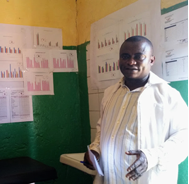“Before this support from PMI, I did not care about data. I mindlessly put together the data from my health area every month and considered it to be an irritating task requested by the health zone. Now, I realize the power of data and understand how it can help me identify issues and improve my services. For example, we decreased the prices of our services in collaboration with the community after we realized that high prices were at the source of low attendance rates. Now, I see a lot more patients. There has been a complete shift in my mindset.”

The nurse of the Lupidi 1 health center in Kapolowe proudly showcases the graphs that are hanging on his office wall.
Previously, the monthly data review meetings in the Lubumbashi and Kapolowe health zones consisted of providers compiling the data from their respective health centers and sending it to the health zone office management team. The office management team followed a similar compilation process for data they received from all the health zones. A lack of knowledge and capacity to verify data accuracy and conduct analysis prevented the providers from utilizing the data to identify issues/trends and make decisions to improve health services.
In May 2016, PMI began supporting the implementation of a strategy to strengthen the routine health information system at the facility level. It targeted five facilities each in Lubumbashi and Kapolowe health zones, located in the southern province of Haut Katanga. The strategy included training health providers in basic monitoring and evaluation skills, building the capacity of the health zone management team to conduct formative supervision, providing the necessary data collection tools and equipment, and coaching providers to conduct data review meetings systematically
The strategy allows the 10 providers trained in this approach to prepare for their data review meetings by collecting data in their health areas in advance, checking for errors and transferring it to a data visualization tool. The data review meetings focus on analyzing trends and developing an action plan based on that. Once the data are validated, providers enter it into the DHIS2 platform, alleviating the health zone’s work load.
Thus far, the results show a marked improvement in performance reporting and case management indicators including report timeliness and completeness, data accuracy, health facility attendance, and the number of pregnant women receiving a second dose of sulfadoxine-pyrimethamine. Furthermore, other health centers, having observed the improved performance of facilities supported through this approach, started modeling the new data review meeting method and independently seeking one-on-one monitoring and evaluation training with health zone staff. One provider even used his personal computer and own resources to start entering his monthly data into DHIS2 with the support of the health zone. This new approach has led to an improvement in performance of the entire health zone.
